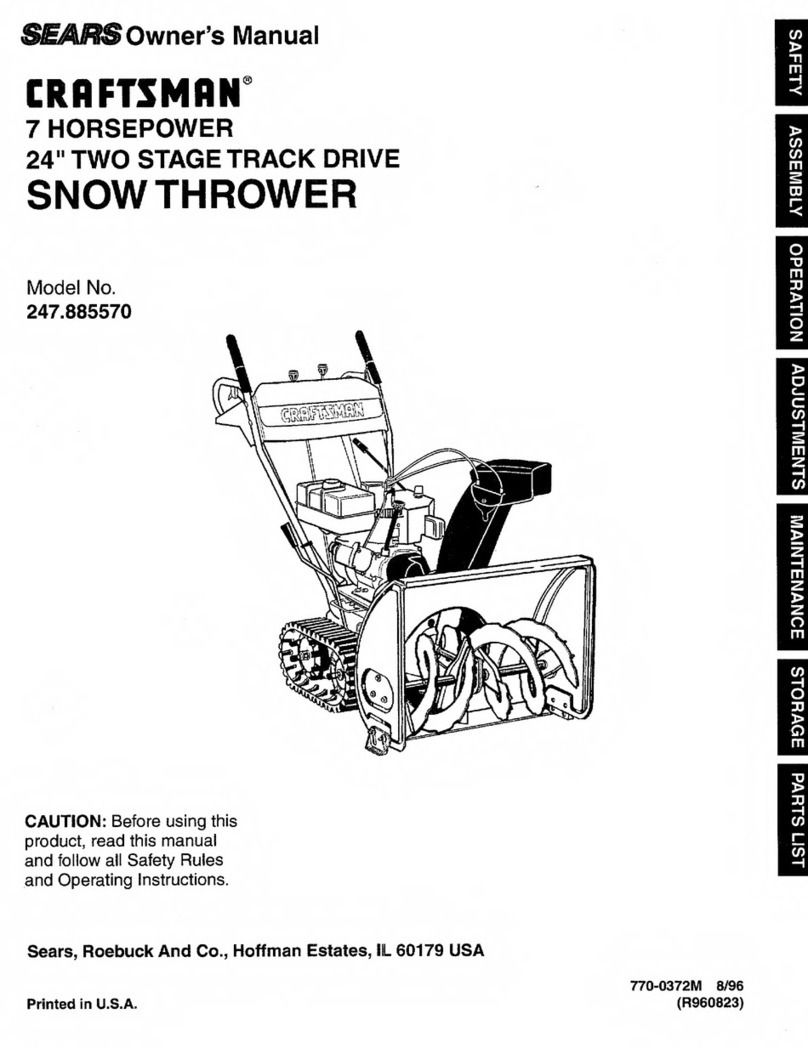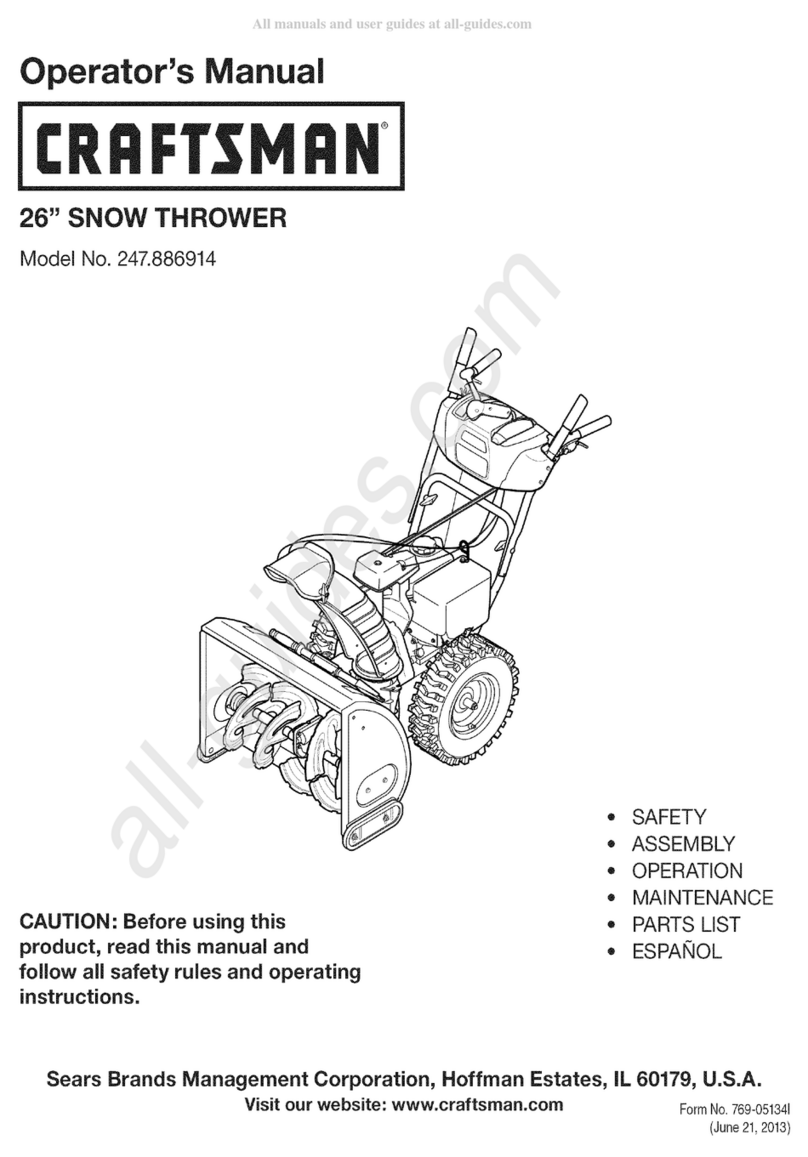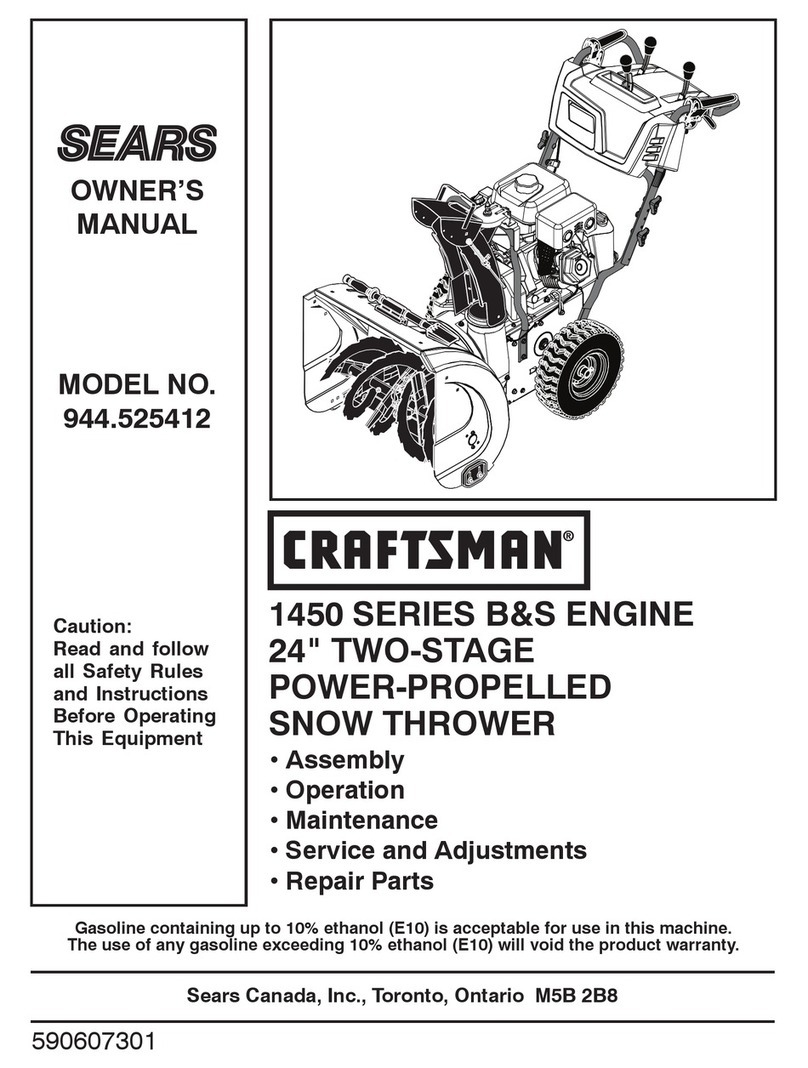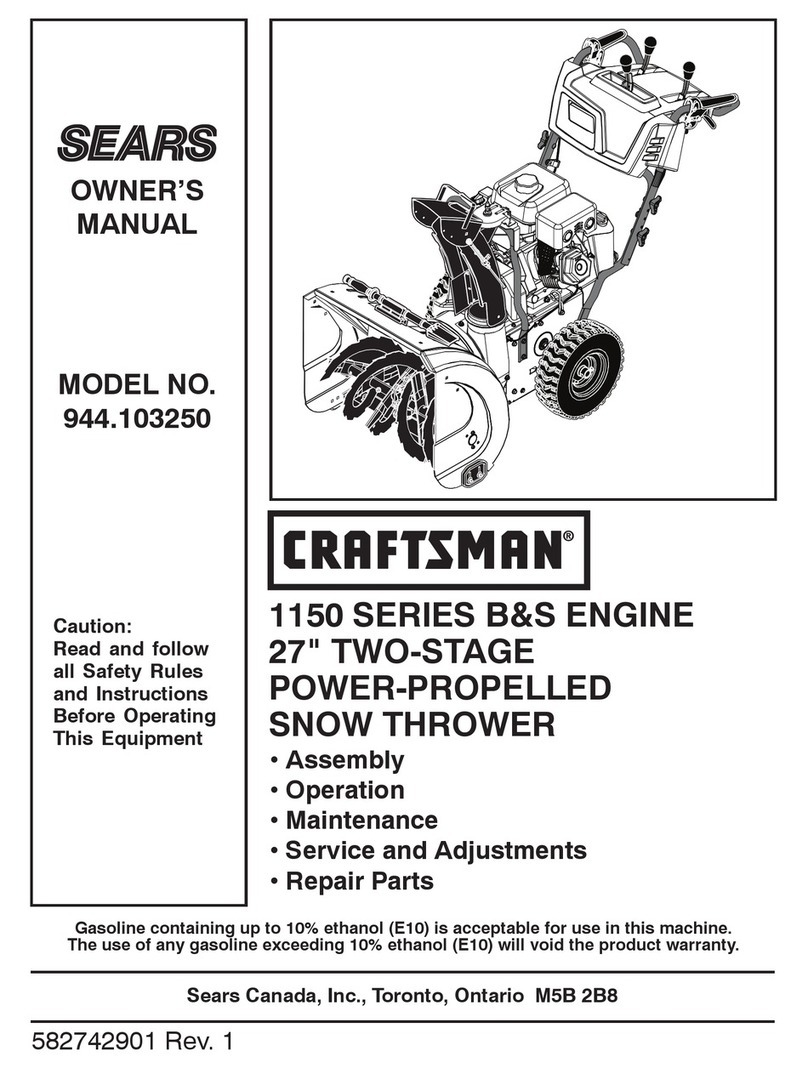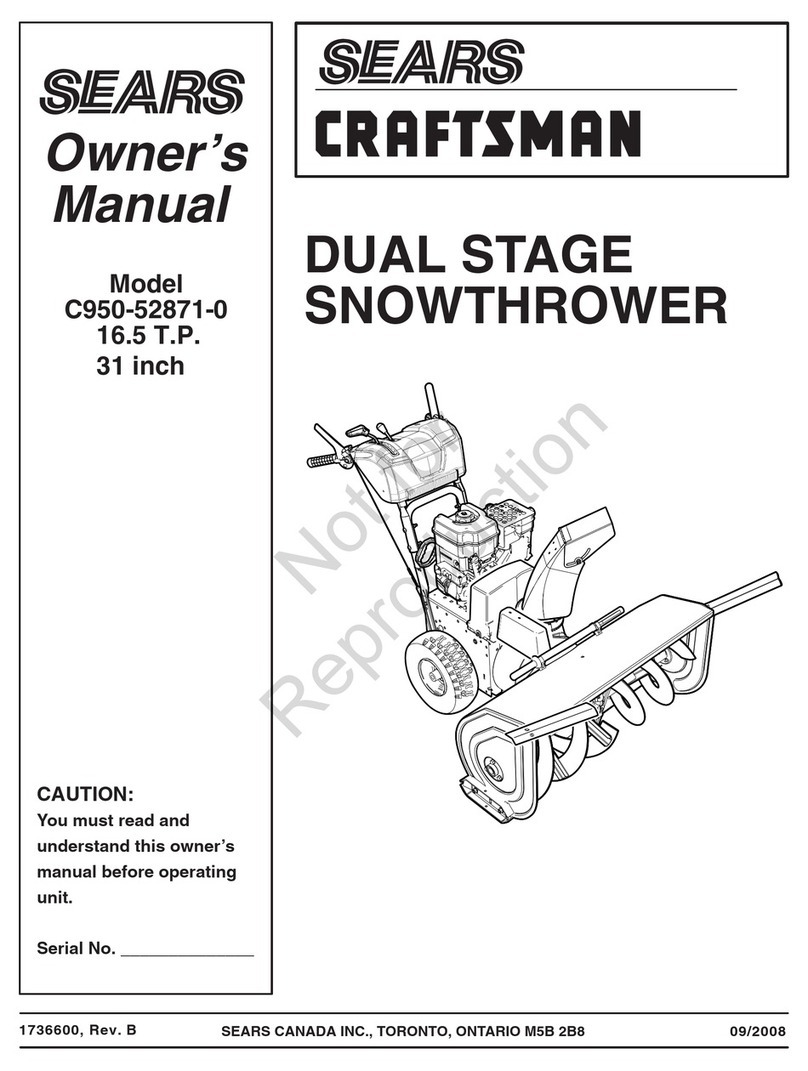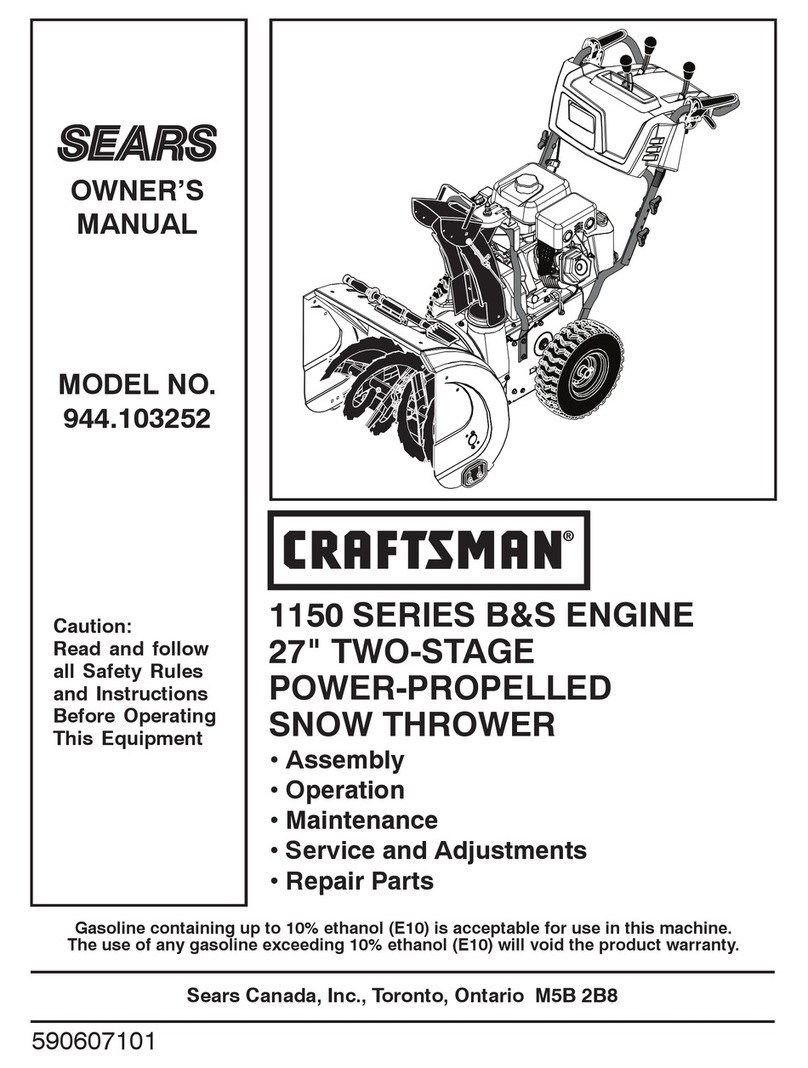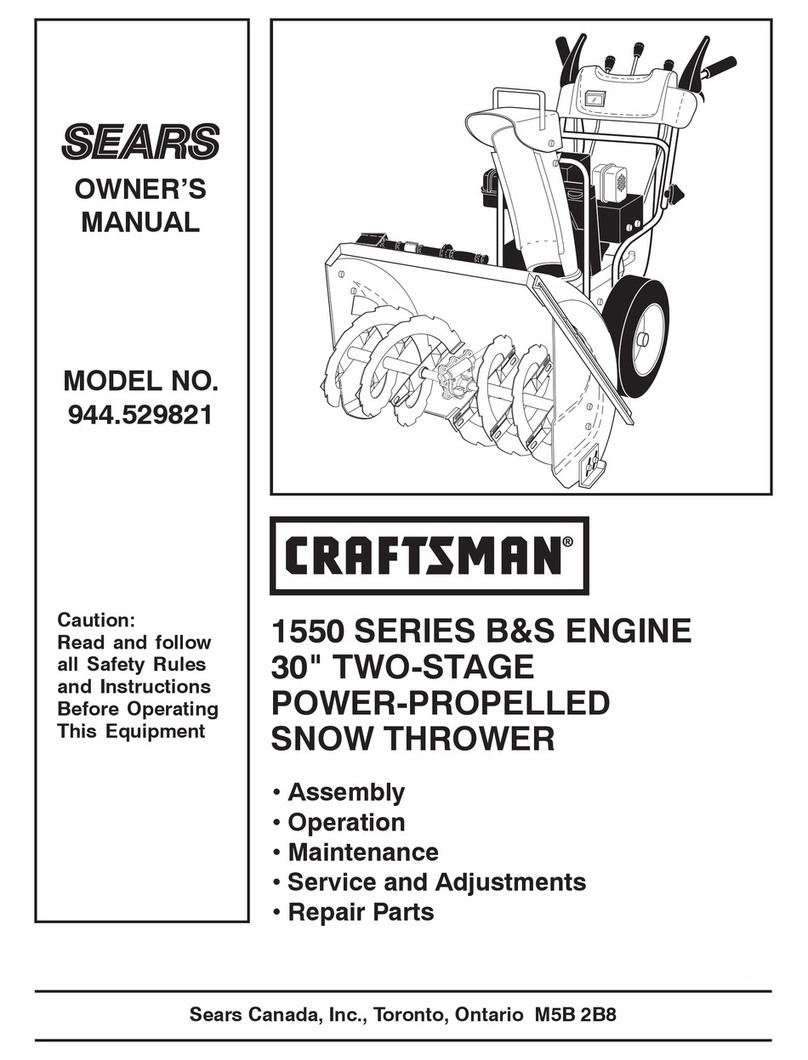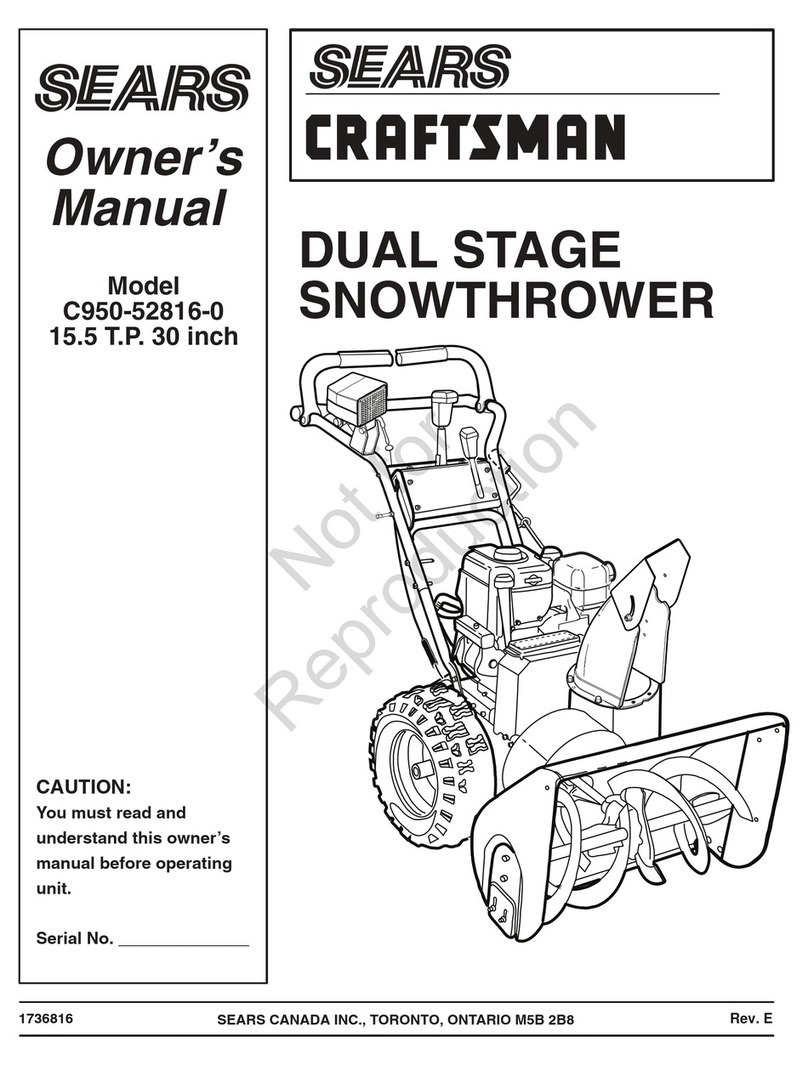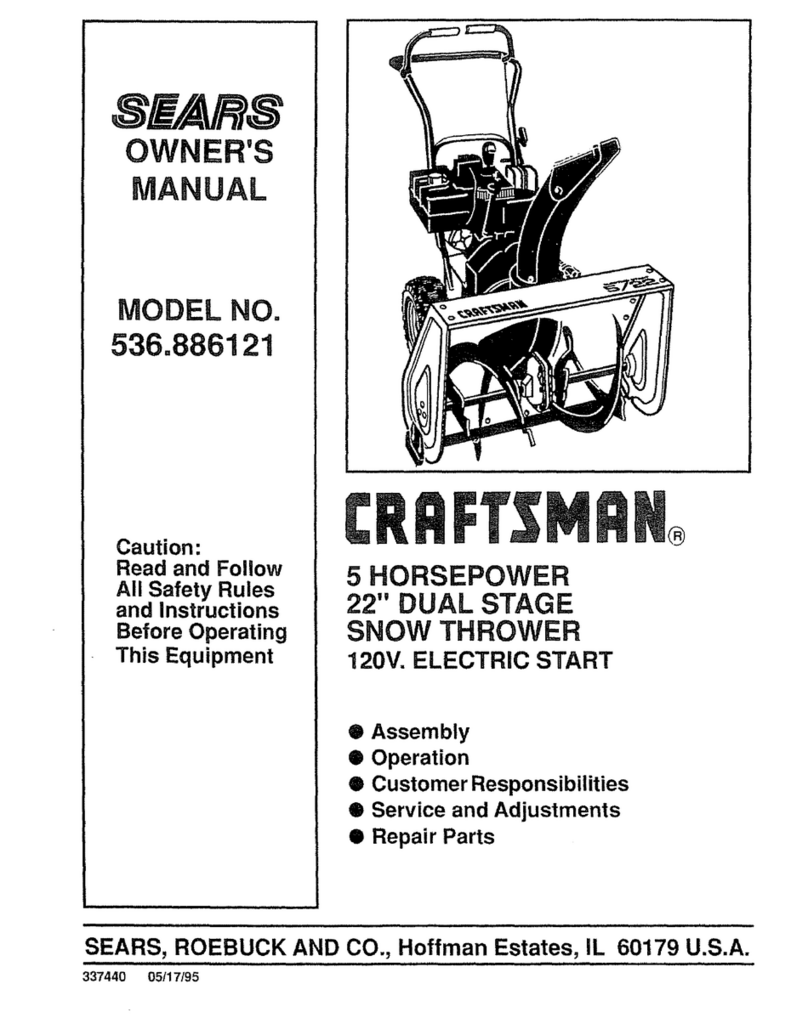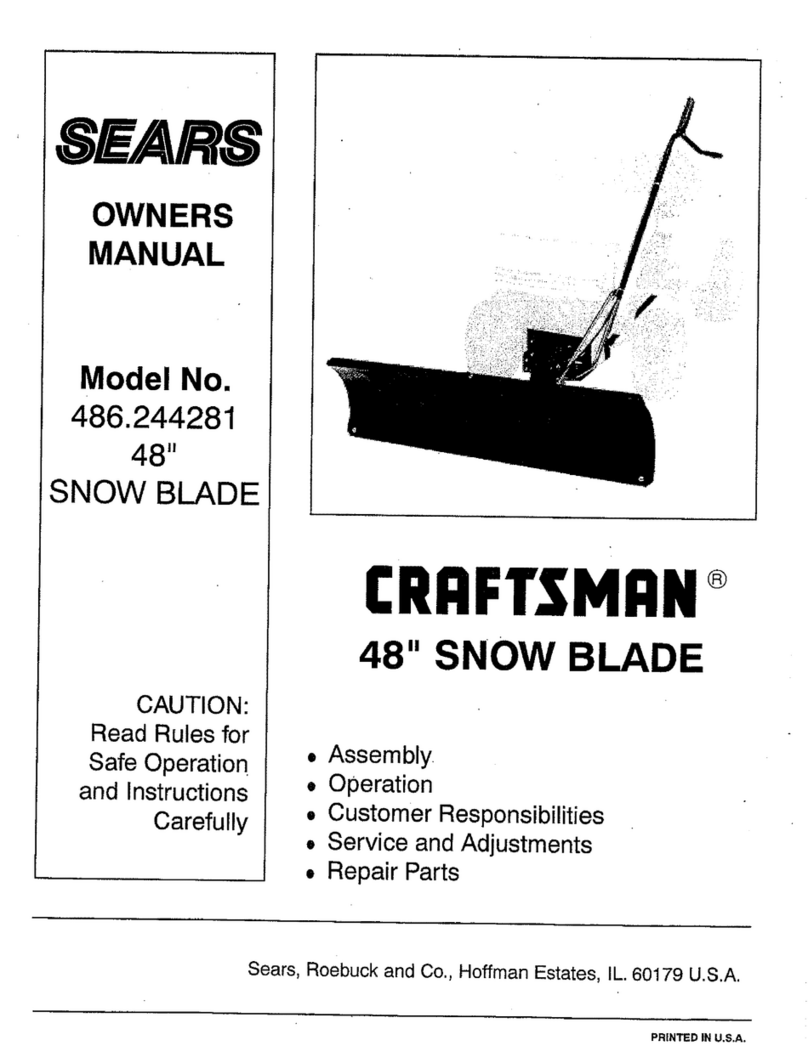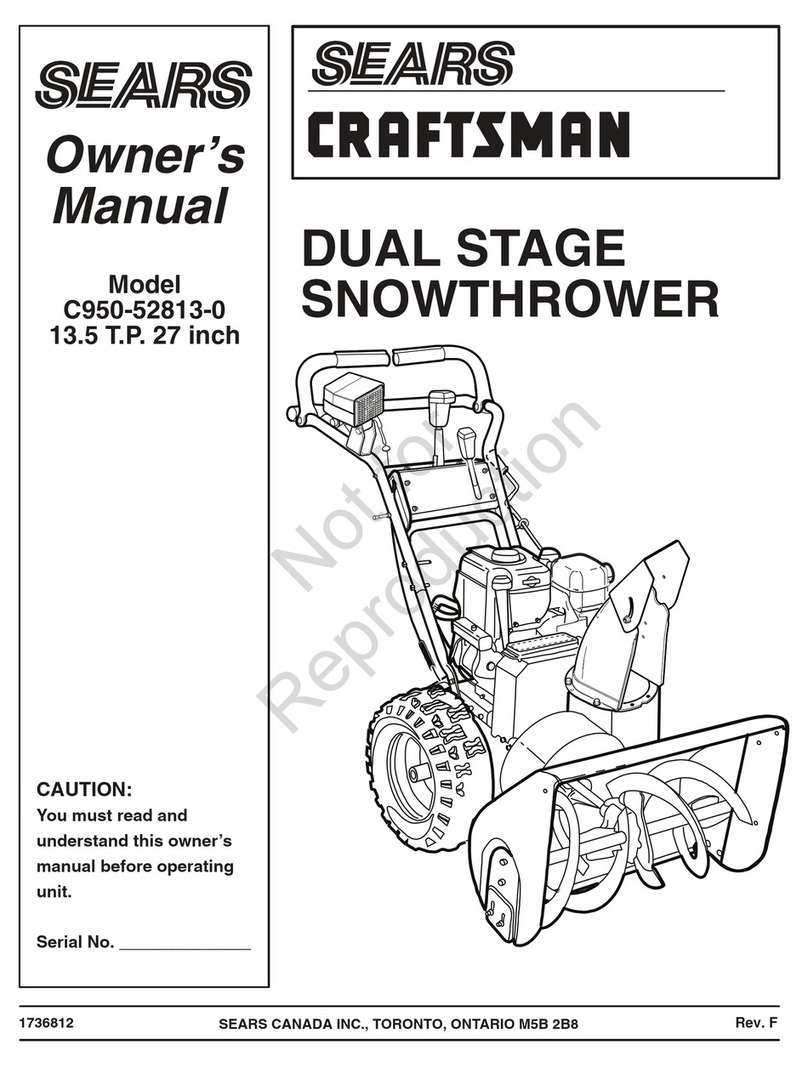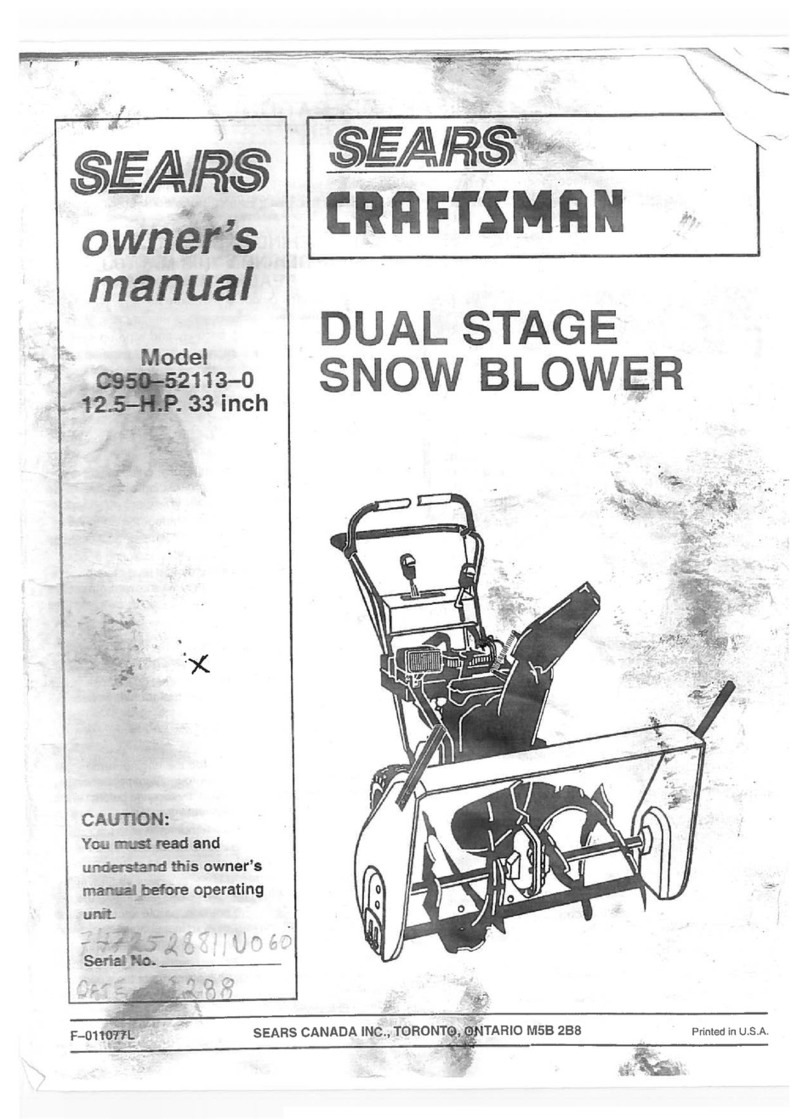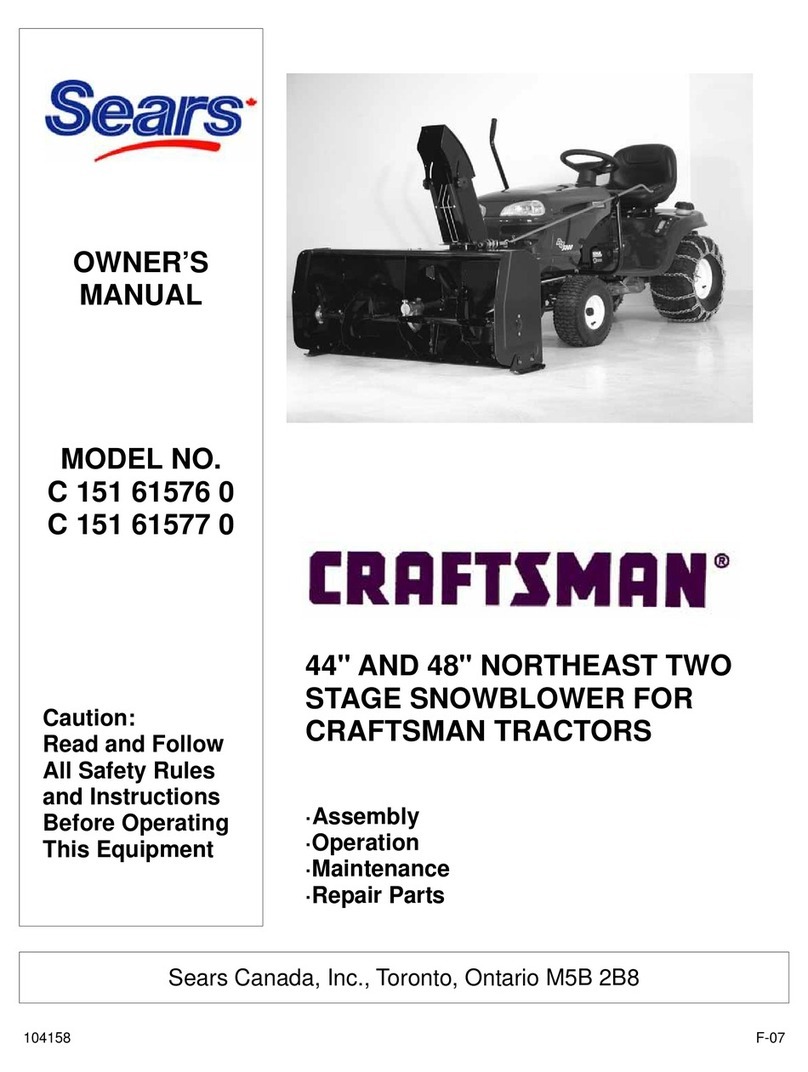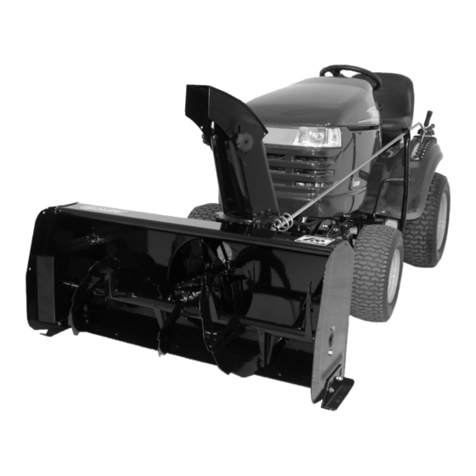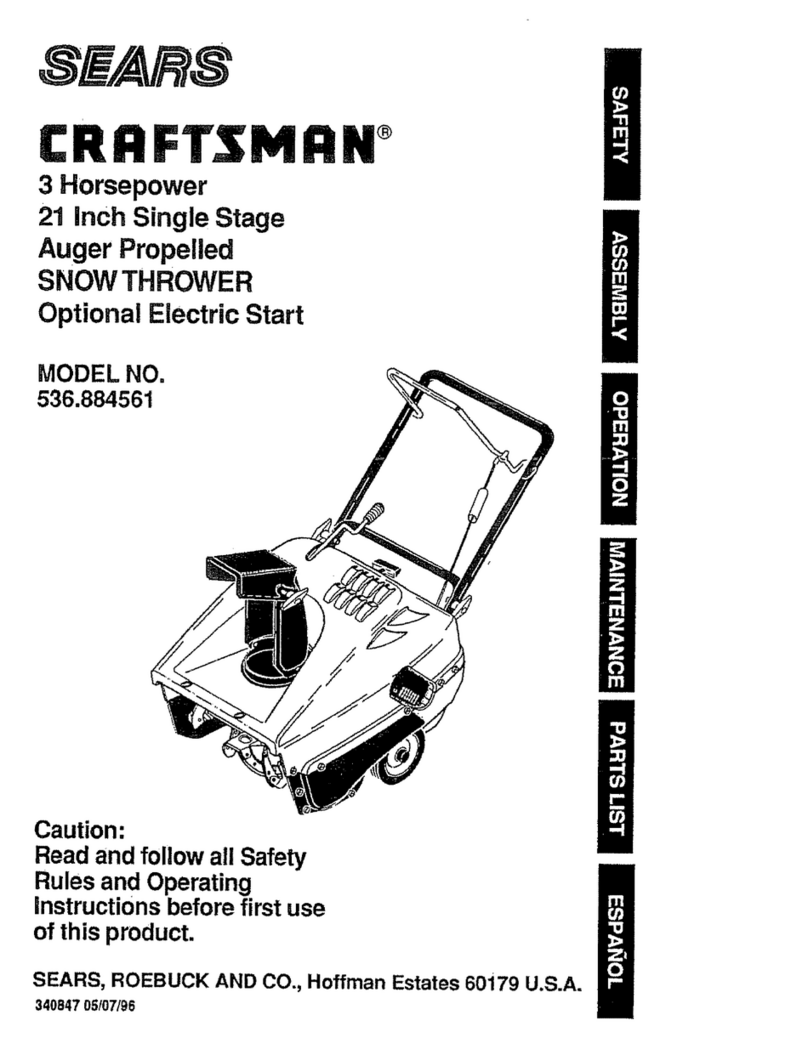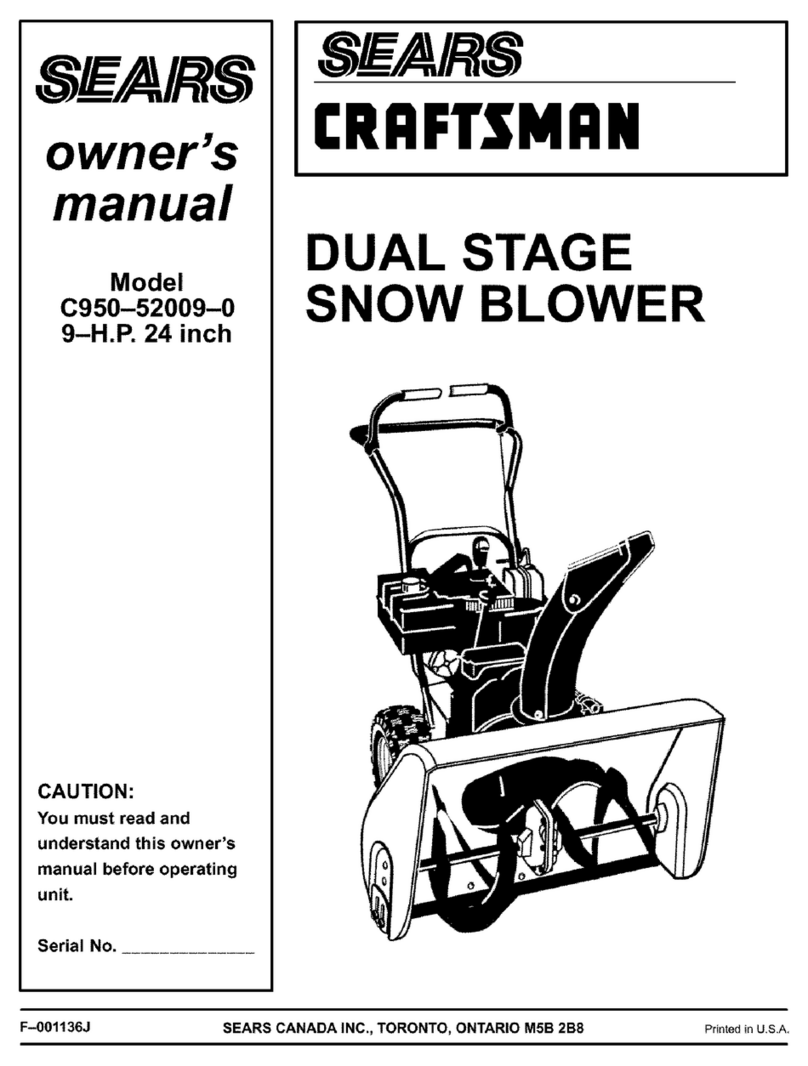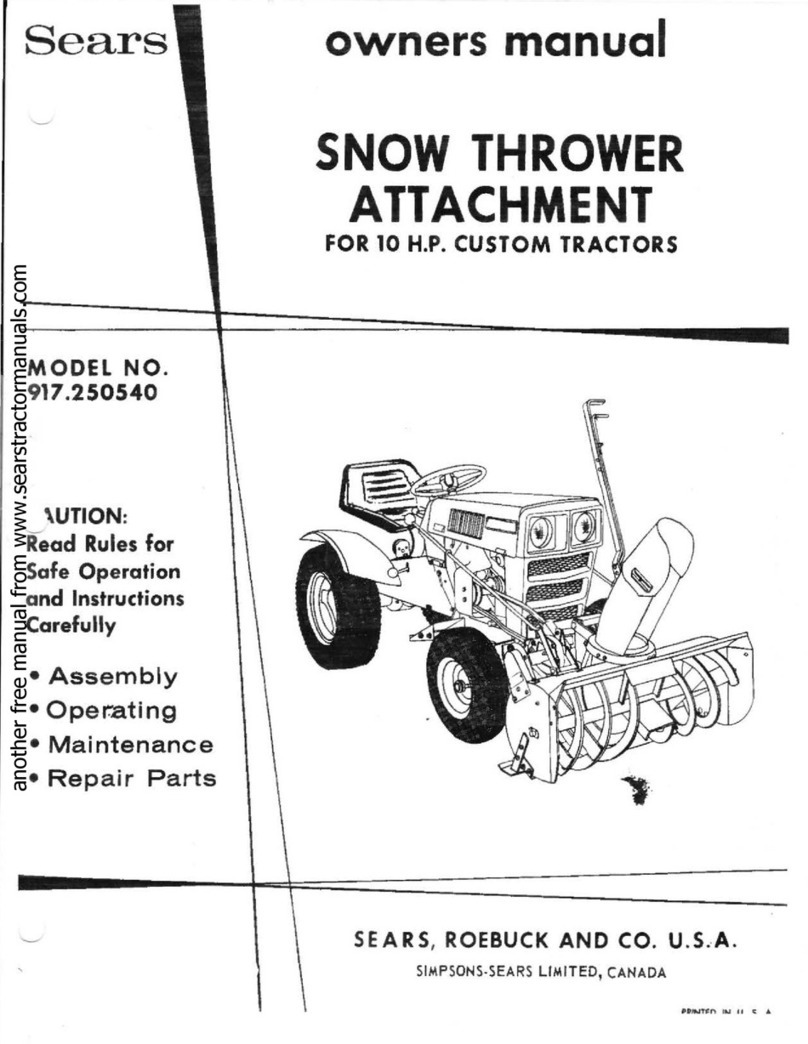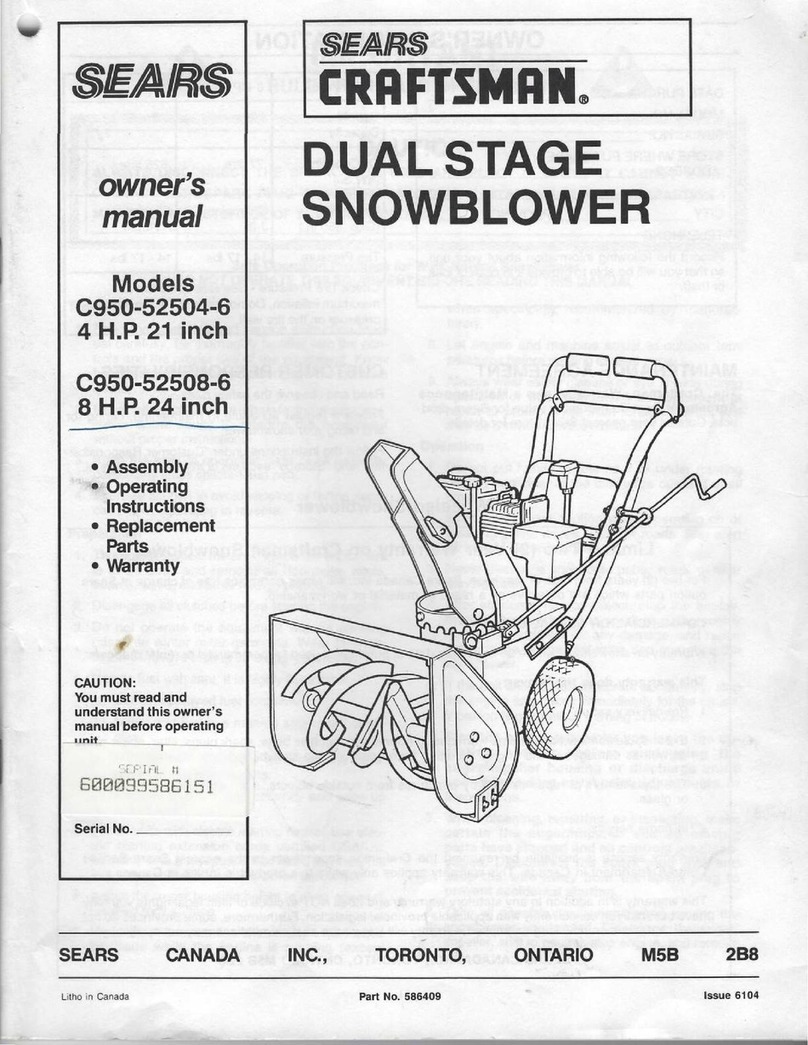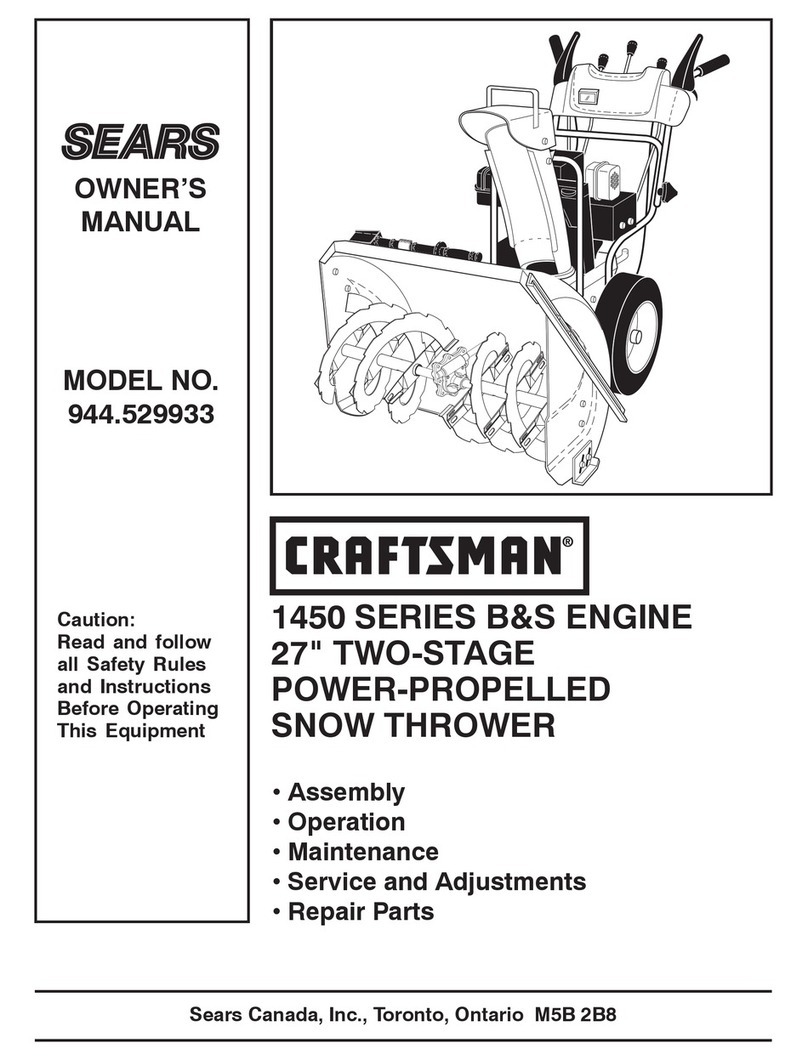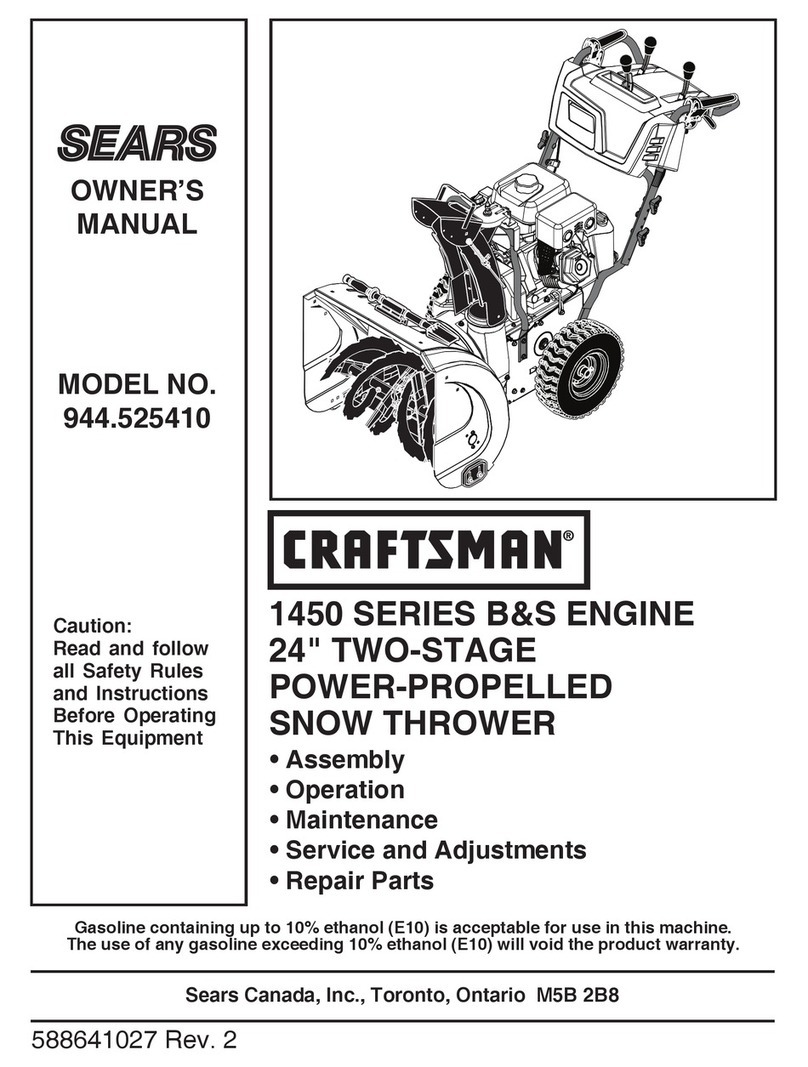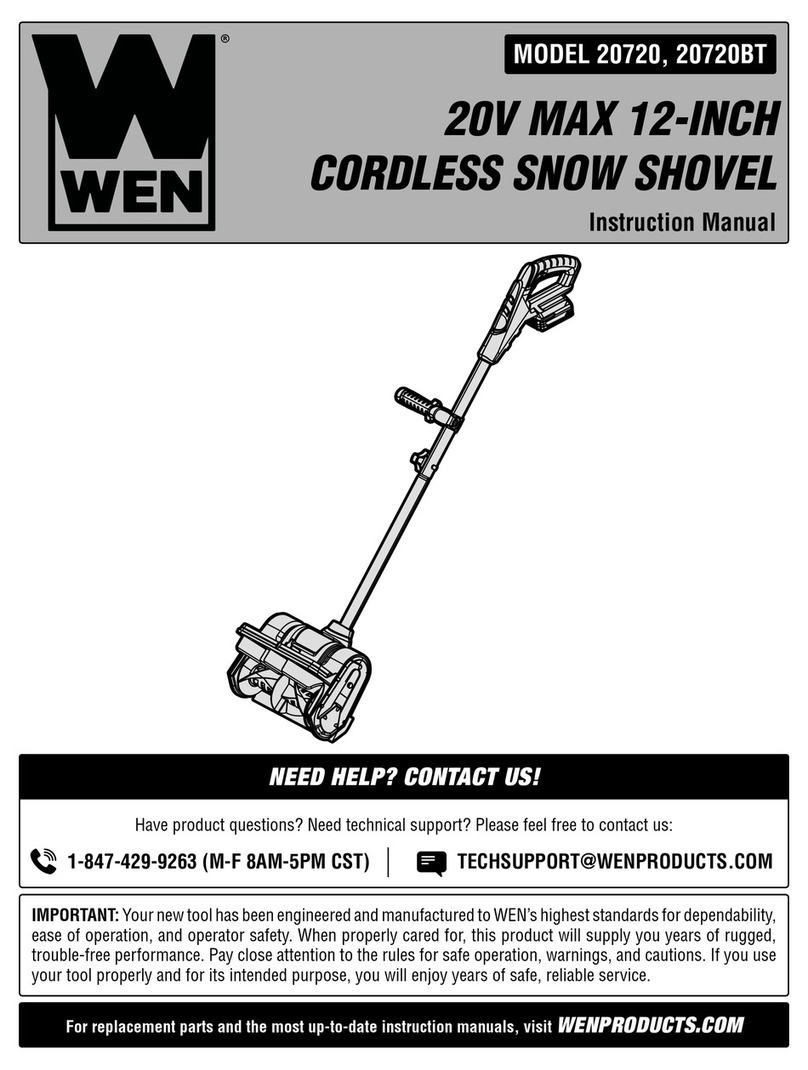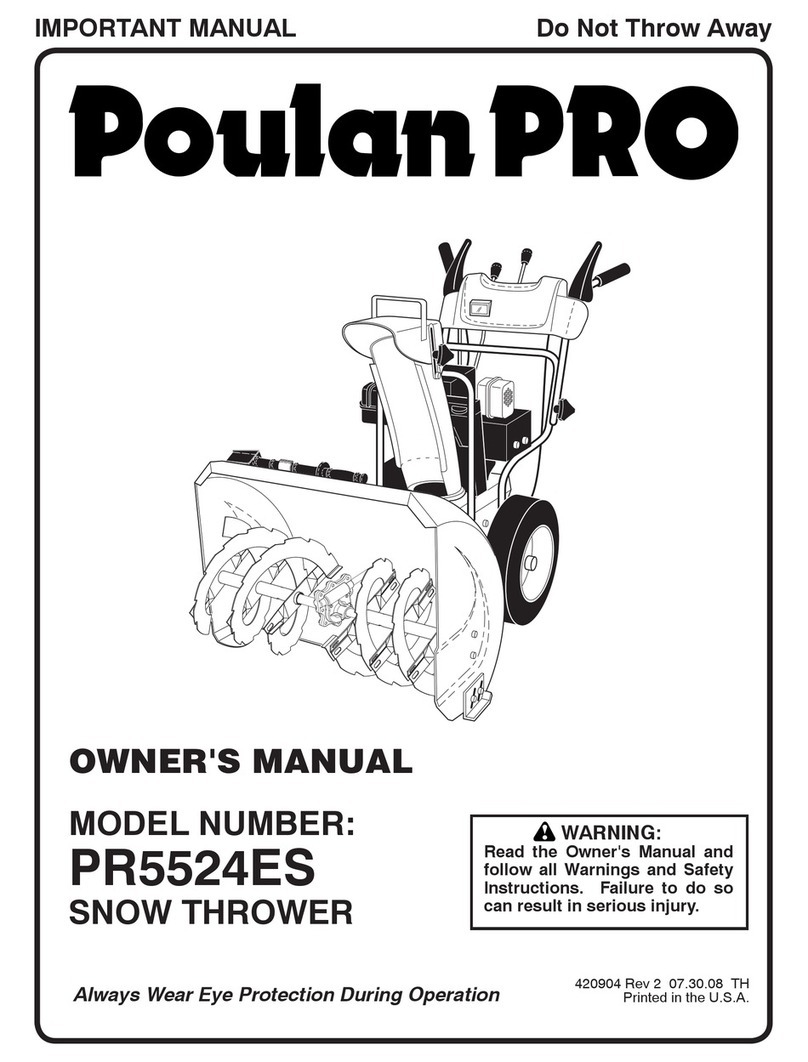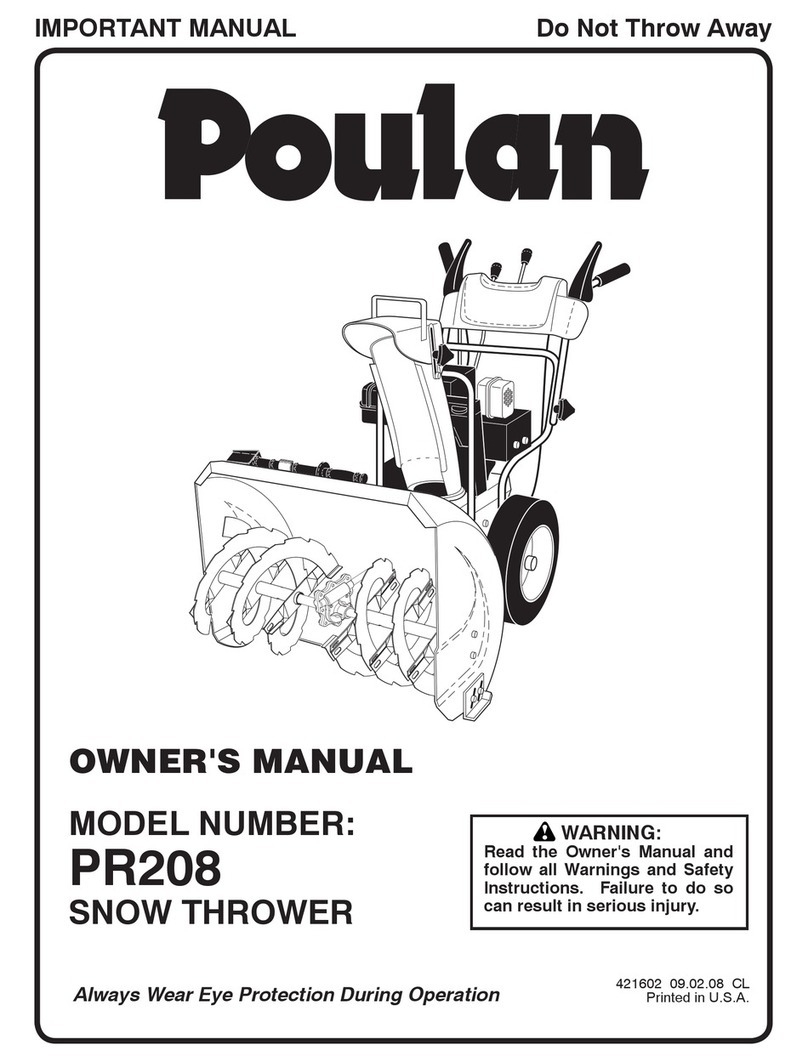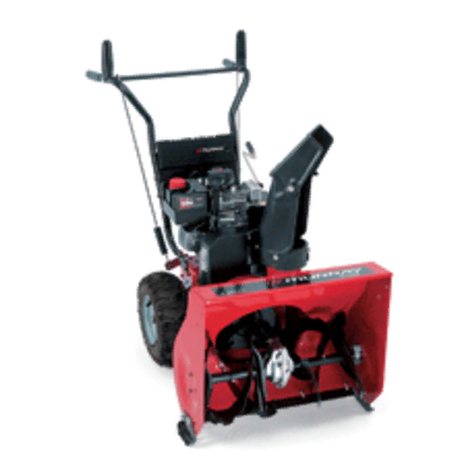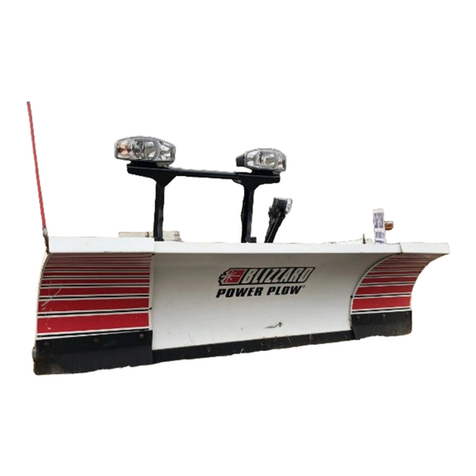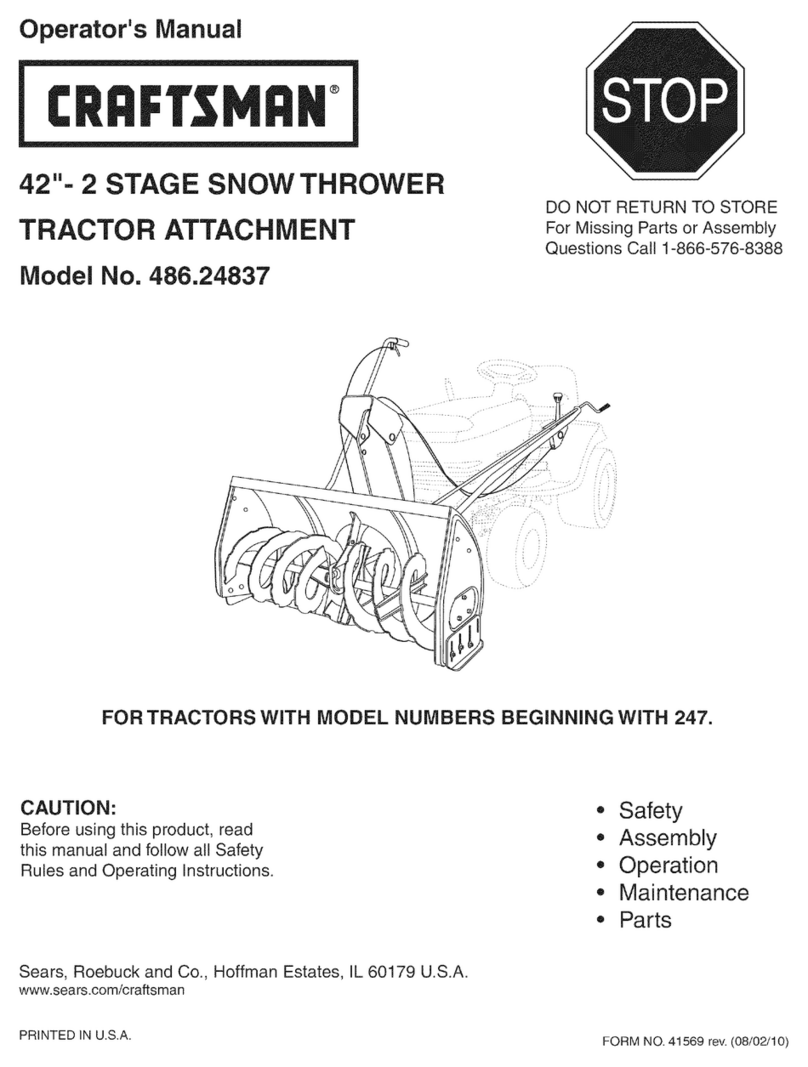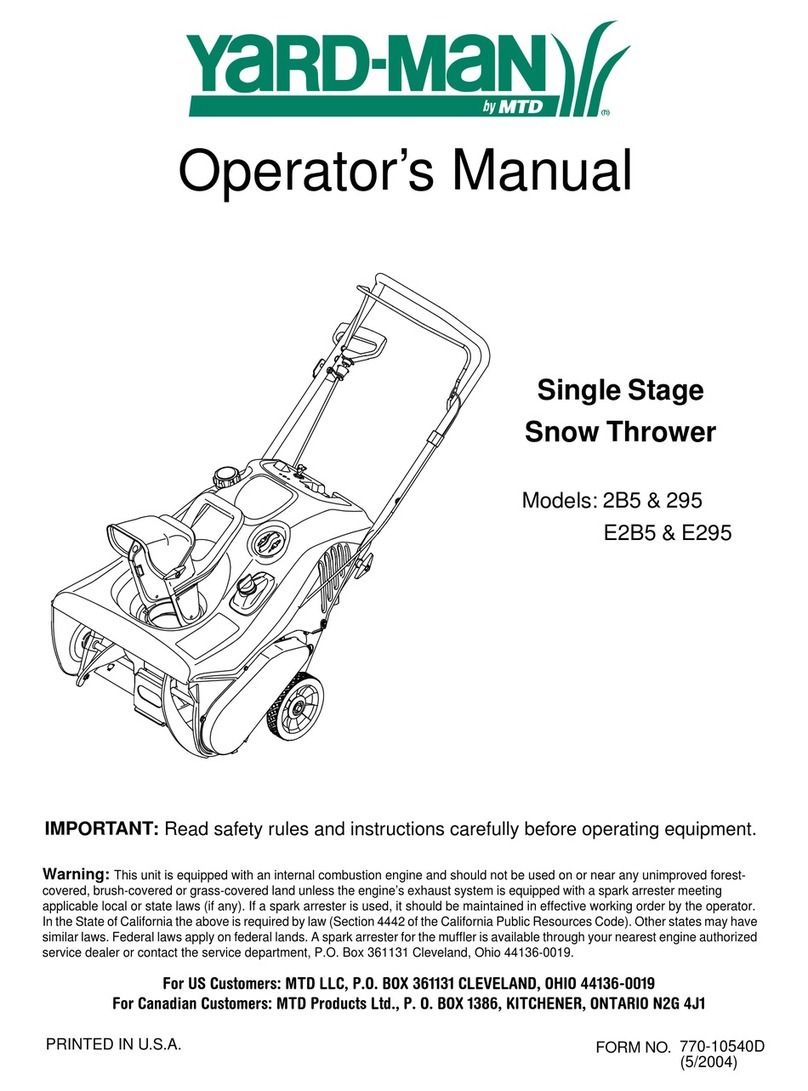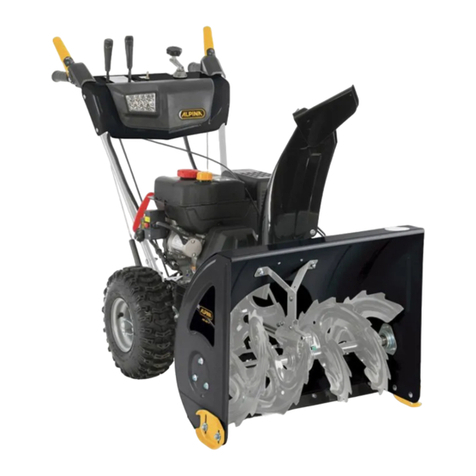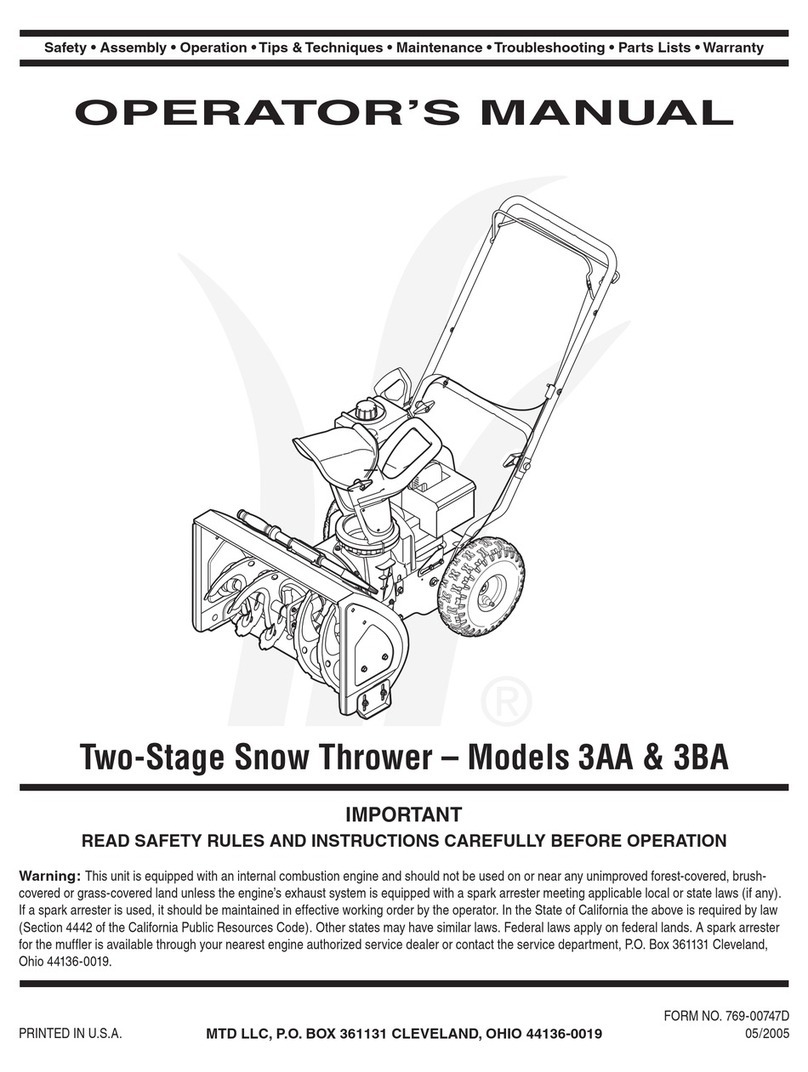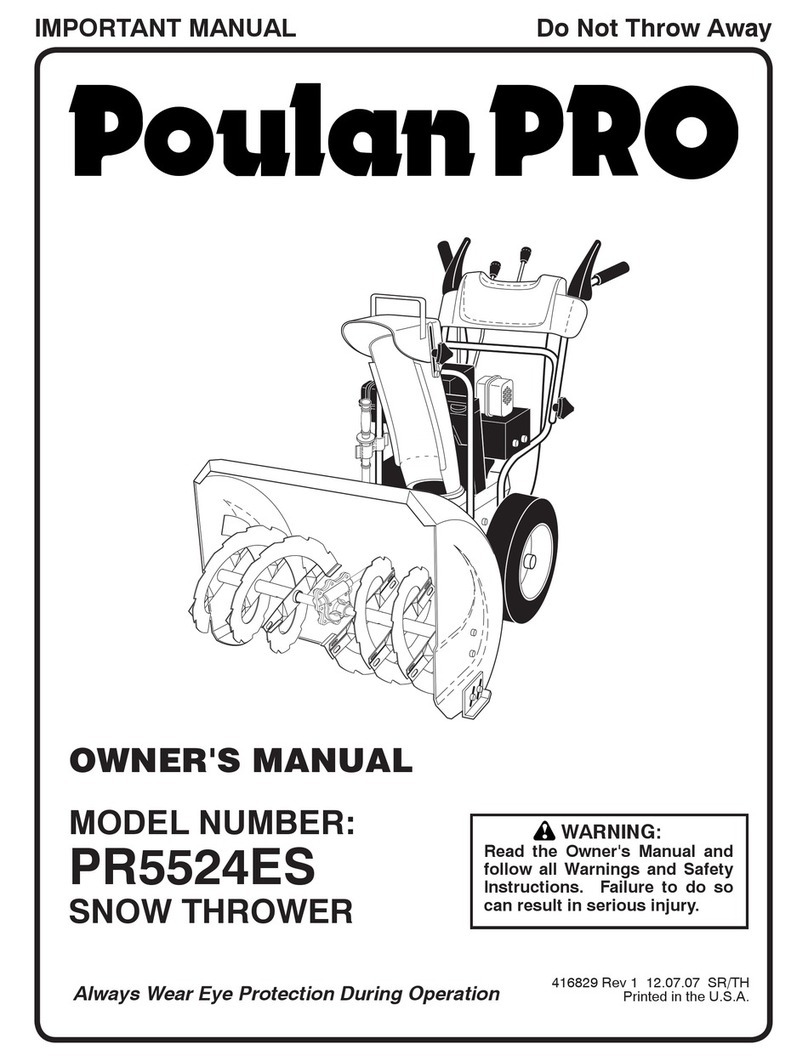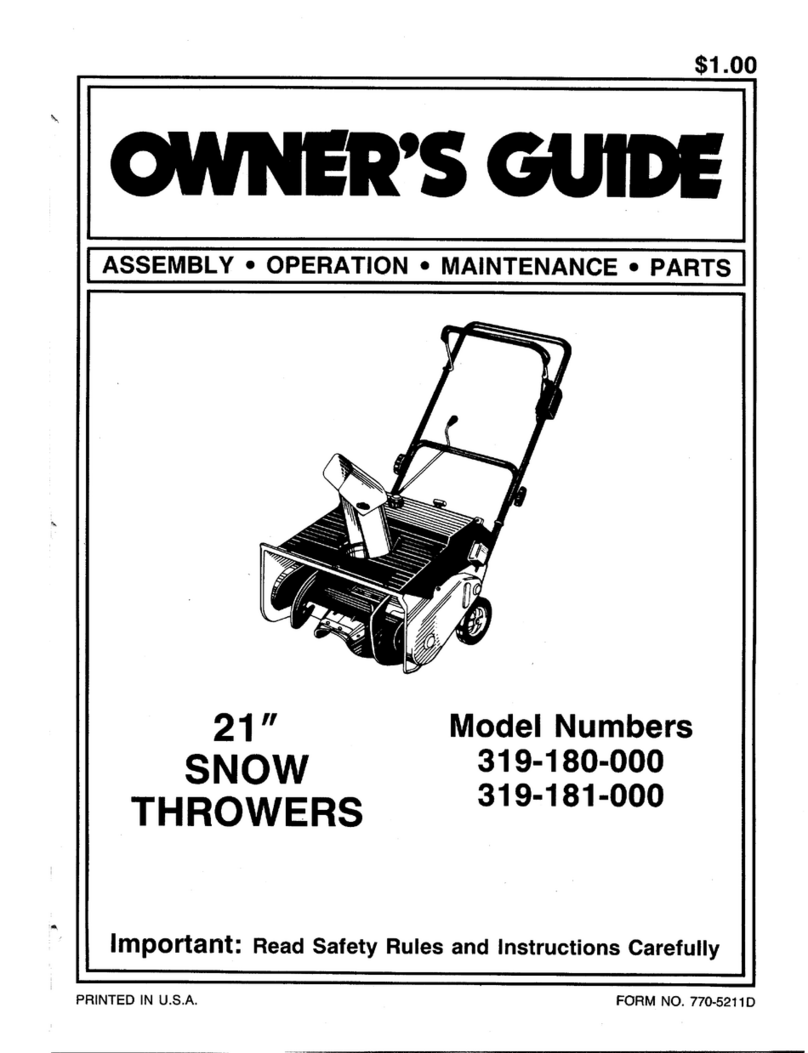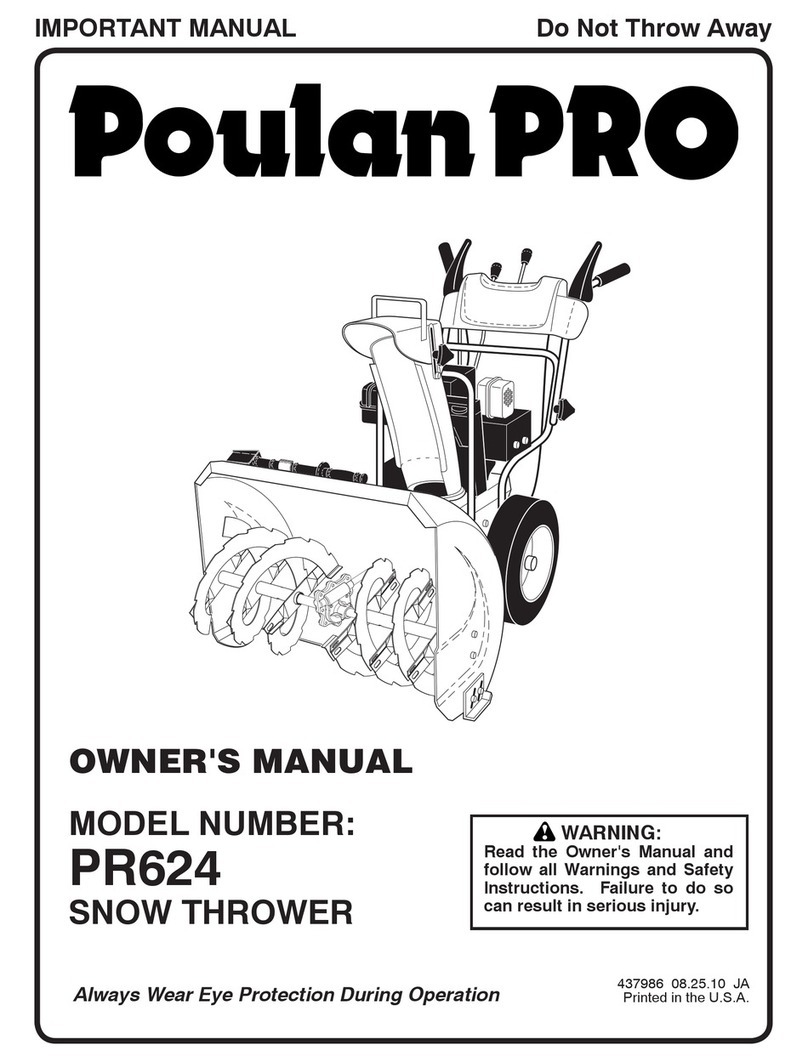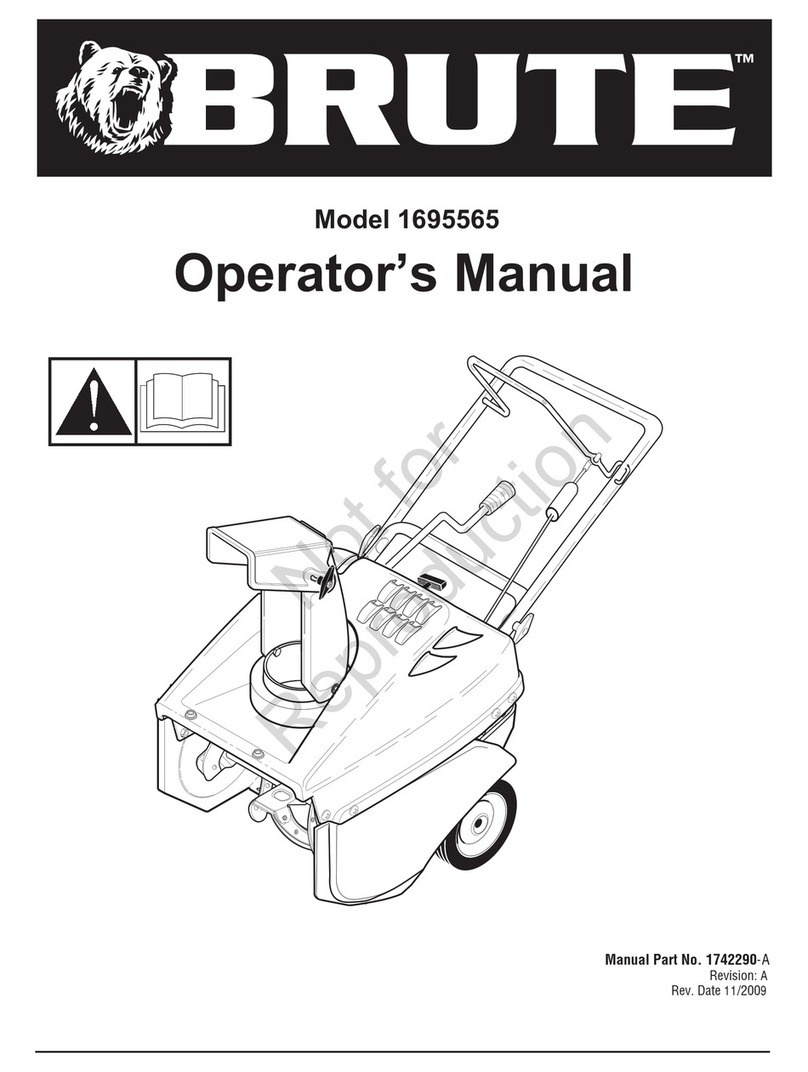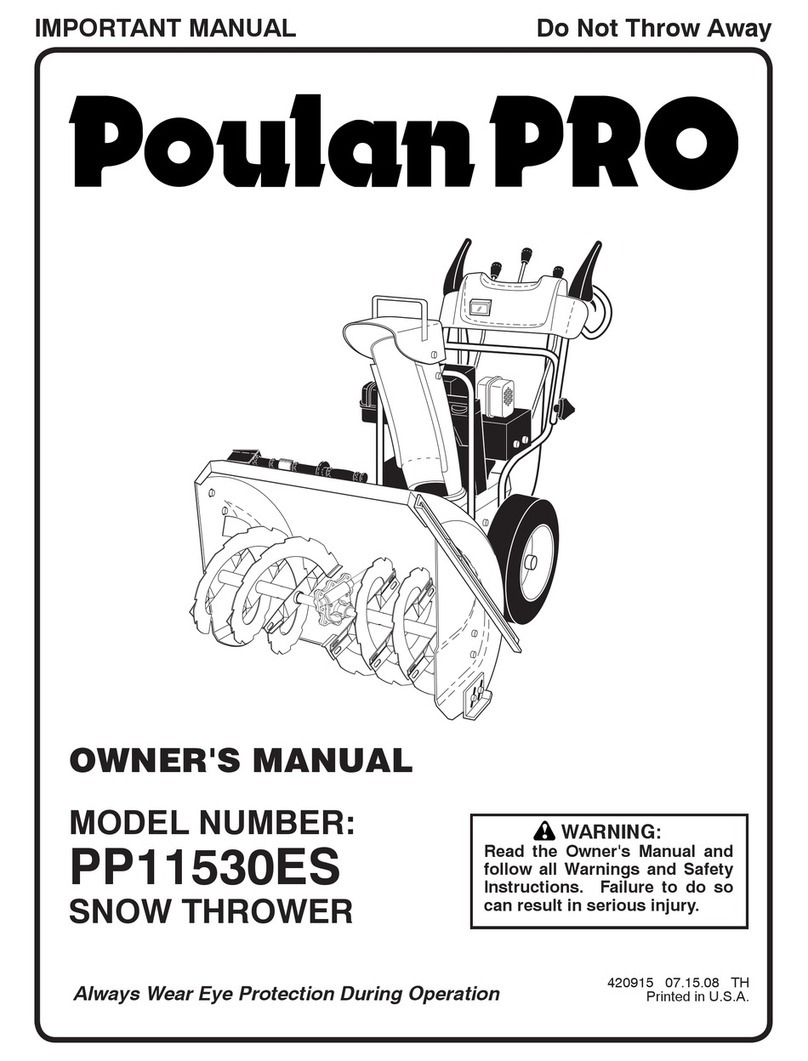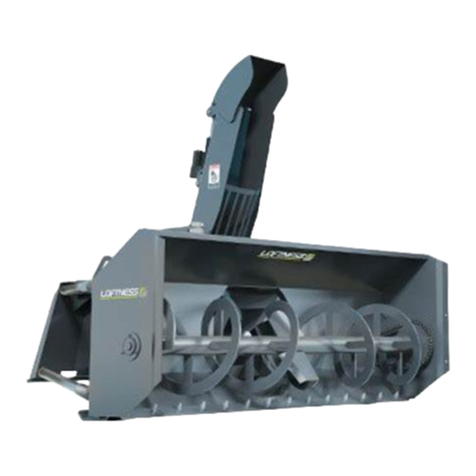
RULES FOR SAFE OPERATION
4
WARNING: This machine is capable ofto amputating hands and feet and throwing objects. Read these safety rules
and follow them closely. Failure to obey these rules could result in loss of control of unit, severe personal injury or
death to you, or bystanders, or damage to property or equipment. The triangle in text signifies important cau-
tions or warnings which must be followed.
Safe Operation Practices for Snowthrowers
IMPORTANT: Safety standards require operator presence controls to minimize
the risk of injury. Your snowthrower is equipped with such controls. Do not
attempt to defeat the function of the operator presence control under any cir-
cumstances.
Training
1. Read, understand, and follow all instructions on the machine and in the
manuals before operating this unit. Be thoroughly familiar with the controls
and the proper use of the equipment. Know how to stop the unit and disen-
gage the controls quickly.
2. Never allow children to operate the equipment. Never allow adults to operate
the equipment without proper instruction.
3. Keep the area of operation clear of all persons, particularly small children
and pets.
4. Exercise caution to avoid slipping or falling especially when operating in
reverse.
Preparation
1. Thoroughly inspect the area where the equipment is to be used and remove
all doormats, sleds, boards, wires, and other foreign objects.
2. Disengage all clutches and shift into neutral before starting the engine
(motor).
3. Do not operate the equipment without wearing adequate winter outer gar-
ments. Wear footwear that will improve footing on slippery surfaces. Avoid
loose fitting clothing that can get caught in moving parts.
4. Handle fuel with care; it is highly flammable.
a. Use an approved fuel container.
b. Never add fuel to a running engine or hot engine.
c. Fill fuel tank outdoors with extreme care. Never fill fuel tank indoors.
Replace fuel cap securely and wipe up spilled fuel.
d. Never fill containers inside a vehicle or on a truck or trailer bed with a
plastic liner. Always place containers on the ground, away from your
vehicle, before filling.
e. When practical, remove gas--powered equipment from the truck or trailer
and refuel it on the ground. If this is not possible, then refuel such on a
trailer with a portable container, rather than from a gasoline dispenser
nozzle.
f. Keep nozzle in contact with the rim of the fuel tank or container opening
at all times, until refueling is complete. Do not use a nozzle lock--open
device.
g. Replace gasoline cap securely and wipe up spilled fuel.
h. If fuel is spilled on clothing, change clothing immediately.
5. Use extension cords and receptacles as specified by the manufacturer for
all units with electric drive motors or electric starting motors.
6. Adjust the collector housing height to clear gravel or crushed rock sur-
faces.
7. Never attempt to make any adjustments while the engine (motor) is running
(except when specifically recommended by manufacturer).
8. Let engine (motor) and snowthrower adjust to outdoor temperatures before
starting to clear snow.
9. Always wear safety glasses or eye shields during operation or while per-
forming an adjustment or repair to protect eyes from foreign objects that
may be thrown from the machine.
Operation
1. Do not put hands or feet near or under rotating parts. Keep clear of the dis-
charge opening at all times.
2. Exercise extreme caution when operating on or crossing gravel drives,
walks or roads. Stay alert for hidden hazards or traffic.
3. After striking a foreign object, stop the engine (motor), remove the wire from
the spark plug, disconnect the cord on electric motors, thoroughly inspect
snowthrower for any damage, and repair the damage before restarting and
operating the snowthrower.
4. If the unit should start to vibrate abnormally, stop the engine (motor) and
check immediately for the cause. Vibration is generally a warning of trouble.
5. Stop the engine (motor) whenever you leave the operating position, before
unclogging the collector/impeller housing or discharge chute and when mak-
ing any repairs, adjustments, or inspections.
6. When cleaning, repairing, or inspecting, make certain the collector/impeller
and all moving parts have stopped. Disconnect the spark plug wire and keep
the wire away from the spark plug to prevent accidental starting.
7. Do not run the engine indoors, except when starting the engine and for
transporting the snowthrower in or out of the building. Open the outside
doors; exhaust fumes are dangerous (containing CARBON MONOXIDE, an
ODORLESS and DEADLY GAS).
8. Exercise extreme caution when operating on slopes. Do not attempt to clear
steep slopes.
9. Never operate the snowthrower without proper guards, plates, or other
safety protective devices in place and working.
10. Never direct the discharge toward people or areas where property damage
can occur. Keep children and others away.
11. Do not overload the machine capacity by attempting to clear snow at too
fast a rate.
12. Never operate the machine at high transport speeds on slippery surfaces.
Look behind and use care when operating in reverse.
13. Disengage power to the collector/impeller when snowthrower is transported
or not in use.
14. Use only attachments and accessories approved by the manufacturer of the
snowthrower (such as cabs, tire chains, etc..).
15. Never operate the snowthrower without good visibility or light. Always be
sure of your footing and keep a firm hold on the handles. Walk, never run.
16. Never touch a hot engine or muffler.
17. Never operate the snowthrower near glass enclosures, automobiles, window
wells, drop--offs, and the like without proper adjustment of the snow dis-
charge angle.
18. Never direct discharge at bystanders or allow anyone in front of the unit.
19. Never leave a running unit unattended. Always disengage the auger and
traction controls, stop engine, and remove keys.
20. Do not operate the unit while under the influence of alcohol or drugs.
21. Keep in mind the operator is responsible for accidents occurring to other
people or property.
22. Data indicates that operators, age 60 years and above, are involved in a
large percentage of power equipment--related injuries. These operators
should evaluate their ability to operate the unit safely enough to protect
themselves and others from injury.
23. DO NOT wear long scarves or loose clothing that could become en-
tangled in moving parts.
24. Snow can hide obstacles. Make sure to remove all obstacles from the
area to be cleared.
Children
Tragic accidents can occur if the operator is not alert to the presence of children.
Children are often attracted to the unit and the operating activity. Never assume that
children will remain where you last saw them.
